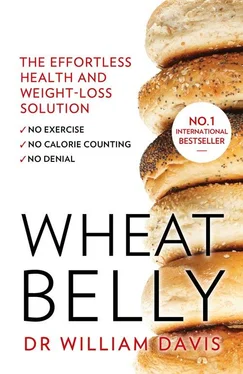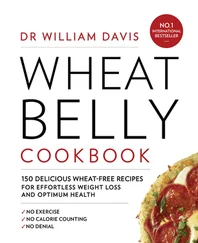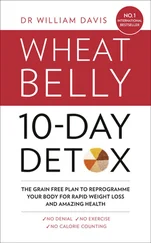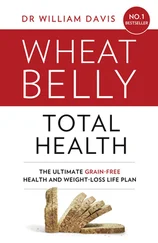1 ...8 9 10 12 13 14 ...19 And so it goes with this human-engineered grass we still call ‘wheat’. Genetic differences generated via thousands of human-engineered hybridisations make for substantial variation in composition, appearance and qualities important not just to chefs and food processors, but also potentially to human health.
CHAPTER 3 Chapter 3 Wheat Deconstructed PART TWO WHEAT AND ITS HEAD-TO-TOE DESTRUCTION OF HEALTH Chapter 4 Hey, Man, Wanna Buy Some Exorphins? The Addictive Properties of Wheat Chapter 5 Your Wheat Belly Is Showing: The Wheat/Obesity Connection Chapter 6 Hello, Intestine. It’s Me, Wheat. Wheat and Coeliac Disease Chapter 7 Diabetes Nation: Wheat and Insulin Resistance Chapter 8 Dropping Acid: Wheat as the Great pH Disrupter Chapter 9 Cataracts, Wrinkles and Dowager’s Humps: Wheat and the Ageing Process Chapter 10 My Particles Are Bigger Than Yours: Wheat and Heart Disease Chapter 11 It’s All in Your Head: Wheat and the Brain Chapter 12 Bagel Face: Wheat’s Destructive Effect on the Skin PART THREE SAY GOODBYE TO WHEAT Chapter 13 Goodbye, Wheat: Create a Healthy, Delicious, Wheat-Free Life Epilogue Appendix A Looking for Wheat in All the Wrong Places Appendix B Healthy Wheat Belly-Shrinking Recipes List of Searchable Terms Acknowledgements References About the Publisher
WHEAT DECONSTRUCTED Chapter 3 Wheat Deconstructed PART TWO WHEAT AND ITS HEAD-TO-TOE DESTRUCTION OF HEALTH Chapter 4 Hey, Man, Wanna Buy Some Exorphins? The Addictive Properties of Wheat Chapter 5 Your Wheat Belly Is Showing: The Wheat/Obesity Connection Chapter 6 Hello, Intestine. It’s Me, Wheat. Wheat and Coeliac Disease Chapter 7 Diabetes Nation: Wheat and Insulin Resistance Chapter 8 Dropping Acid: Wheat as the Great pH Disrupter Chapter 9 Cataracts, Wrinkles and Dowager’s Humps: Wheat and the Ageing Process Chapter 10 My Particles Are Bigger Than Yours: Wheat and Heart Disease Chapter 11 It’s All in Your Head: Wheat and the Brain Chapter 12 Bagel Face: Wheat’s Destructive Effect on the Skin PART THREE SAY GOODBYE TO WHEAT Chapter 13 Goodbye, Wheat: Create a Healthy, Delicious, Wheat-Free Life Epilogue Appendix A Looking for Wheat in All the Wrong Places Appendix B Healthy Wheat Belly-Shrinking Recipes List of Searchable Terms Acknowledgements References About the Publisher
WHETHER IT’S A LOAF OF organic high-fibre multigrain bread or a mass-produced biscuit, what exactly are you eating? We all know that the biscuit is just a processed indulgence, but conventional advice tells us that the former is a better health choice, a source of fibre and B vitamins, and rich in ‘complex’ carbohydrates.
Ah, but there’s always another layer to the story. Let’s peer inside the contents of this grain and try to understand why – regardless of shape, colour, fibre content, organic or not – it potentially does odd things to humans.
WHEAT: SUPERCARBOHYDRATE
The transformation of the domesticated wild grass of Neolithic times into the modern brownies, cupcakes or Victoria sponge requires some serious sleight of hand. These modern configurations were not possible with the dough of ancient wheat. An attempt to make a modern jam doughnut with einkorn wheat, for example, would yield a crumbly mess that would not hold its filling, and it would taste, feel and look like, well, a crumbly mess. In addition to hybridising wheat for increased yield, plant geneticists have also sought to generate hybrids that have properties best suited to become, for instance, a chocolate cupcake or a seven-tiered wedding cake.
Modern Triticum aestivum wheat flour is, on average, 70 per cent carbohydrate by weight, with protein and indigestible fibre each comprising 10 to 15 per cent. The small remaining weight of Triti cum wheat flour is fat, mostly phospholipids and polyunsaturated fatty acids. 1(Interestingly, ancient wheat has higher protein content. Emmer wheat, for instance, contains 28 per cent or more protein. 2)
Wheat starches are the complex carbohydrates that are the darlings of dietitians. ‘Complex’ means that the carbohydrates in wheat are composed of polymers (repeating chains) of the simple sugar, glucose, unlike simple carbohydrates such as sucrose, which are one- or two-unit sugar structures. (Sucrose is a two-sugar molecule, glucose + fructose.) Conventional wisdom, such as that from your dietitian or the USDA, says we should all reduce our consumption of simple carbohydrates in the form of sweets and fizzy drinks, and increase our consumption of complex carbohydrates.
Of the complex carbohydrate in wheat, 75 per cent is the chain of branching glucose units, amylopectin , and 25 per cent is the linear chain of glucose units, amylose . In the human gastrointestinal tract, both amylopectin and amylose are digested by the salivary and stomach enzyme amylase. Amylopectin is efficiently digested by amylase to glucose, while amylose is much less efficiently digested, some of it making its way to the colon undigested. Thus, the complex carbohydrate amylopectin is rapidly converted to glucose and absorbed into the bloodstream and, because it is most efficiently digested, is mainly responsible for wheat’s blood-sugar-increasing effect.
Other carbohydrate foods also contain amylopectin, but not the same kind of amylopectin as wheat. The branching structure of amylopectin varies depending on its source. 3Amylopectin from legumes, so-called amylopectin C, is the least digestible – hence the schoolkid’s chant, ‘Beans, beans, they’re good for your heart, the more you eat ’em, the more you. . . .’ Undigested amylopectin makes its way to the colon, whereupon the symbiotic bacteria happily dwelling there feast on the undigested starches and generate gases such as nitrogen and hydrogen, making the sugars unavailable for you to digest.
Amylopectin B is the form found in bananas and potatoes and, while more digestible than bean amylopectin C, still resists digestion to some degree. The most digestible form of amylopectin, amylopectin A, is the form found in wheat. Because it is the most digestible, it is the form that most enthusiastically increases blood sugar. This explains why, gram for gram, wheat increases blood sugar to a greater degree than, say, kidney beans or crisps. The amylopectin A of wheat products, complex or no, might be regarded as a supercarbohydrate, a form of highly digestible carbohydrate that is more efficiently converted to blood sugar than nearly all other carbohydrate foods, simple or complex.
This means that not all complex carbohydrates are created equal, with amylopectin A-containing wheat increasing blood sugar more than other complex carbohydrates. But the uniquely digestible amylopectin A of wheat also means that the complex carbohydrate of wheat products, on a gram-for-gram basis, are no better, and are often worse, than even simple carbohydrates such as sucrose.
People are usually shocked when I tell them that whole-wheat bread increases blood sugar to a higher level than sucrose. 4Aside from some extra fibre, eating two slices of whole-wheat bread is really little different, and often worse, than drinking a can of a sugar-sweetened fizzy drink or eating a sugary chocolate bar.
This information is not new. A 1981 University of Toronto study launched the concept of the glycaemic index, i.e., the comparative blood sugar effects of carbohydrates: the higher the blood sugar after consuming a specific food compared to glucose, the higher the glycaemic index (GI). The original study showed that the GI of white bread was 69, while the GI of whole-grain bread was 72 and Shredded Wheat cereal was 67, while that of sucrose (table sugar) was 59. 5Yes, the GI of whole-grain bread is higher than that of sucrose. Incidentally, the GI of a Mars bar – nougat, chocolate, sugar, caramel and all – is 68. That’s better than whole-grain bread. The GI of a Snickers bar is 41 – far better than whole-grain bread.
Читать дальше












